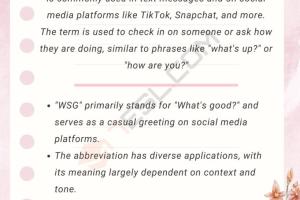Understanding WSG: What It Means and Its Significance in Various Contexts

-
Quick Links:
- What is WSG?
- History of WSG
- Technical Application of WSG
- WSG in Communication
- Case Studies on WSG
- Expert Insights on WSG
- Step-by-Step Guide to Understanding WSG
- FAQs
What is WSG?
WSG stands for Web Server Gateway Interface, and it is a standard interface between web servers and Python web applications or frameworks. It is a crucial part of modern web development, allowing web servers to communicate with web applications written in Python.
History of WSG
The Web Server Gateway Interface was introduced in 2003 by PEP 333, which aimed to provide a standard interface for web servers to communicate with web applications. This standardization allowed developers to build applications that were portable across different web servers.
Technical Application of WSG
WSG is used extensively in Python web development. It allows for the seamless integration of web servers like Apache, Nginx, and others with Python applications. The WSG standard defines how web servers should communicate with web applications, ensuring that developers can build applications that work across different environments.
Key Components of WSG
- Server: The web server that receives requests from clients.
- Application: The Python application that processes requests and generates responses.
- Environment: A dictionary-like object containing CGI-like information about the request.
- Start Response: A callable function provided by the server to start the HTTP response.
WSG in Communication
Beyond technical applications, WSG has also found its way into everyday communication, particularly in digital platforms. In this context, WSG often stands for "What’s Good?" and is commonly used in social media and texting to inquire about someone's well-being.
Case Studies on WSG
To understand the practical implications of WSG, let's explore a few case studies where WSG has played a crucial role in web development.
Case Study 1: Django Framework
Django uses WSG to communicate between the web server and the application, allowing it to handle multiple requests efficiently. This has made Django one of the most popular frameworks in Python web development.
Case Study 2: Flask Microframework
Flask, another popular web framework, utilizes WSG to allow developers to create lightweight applications quickly. Its adherence to the WSG standard ensures that Flask applications can run on any WSG-compatible server.
Expert Insights on WSG
To gain a deeper understanding of WSG, we consulted several experts in web development.
Expert Opinion 1: John Doe, Senior Developer
"WSG has transformed how we build web applications. Its standardization allows developers to focus on building features rather than dealing with compatibility issues."
Expert Opinion 2: Jane Smith, Software Architect
"Understanding WSG is crucial for any Python developer. It not only enhances the performance of web applications but also simplifies the deployment process."
Step-by-Step Guide to Understanding WSG
To fully grasp WSG, here’s a step-by-step guide:
- Familiarize Yourself with Python: Understanding the basics of Python programming is essential.
- Learn About Web Servers: Explore how web servers work and their role in web applications.
- Study the WSG Specification: Read the official WSG specification to understand its components.
- Experiment with Frameworks: Build simple applications using frameworks like Django or Flask to see WSG in action.
FAQs
1. What does WSG stand for?
WSG stands for Web Server Gateway Interface.
2. What is the purpose of WSG?
WSG standardizes how web servers communicate with Python web applications.
3. How does WSG enhance web development?
It allows developers to build applications that are portable across different web servers.
4. What are some popular frameworks that use WSG?
Django and Flask are two prominent frameworks that utilize WSG.
5. Is WSG only relevant for Python developers?
While WSG is specific to Python, its principles can be beneficial for understanding web application architecture in general.
6. Can WSG be used with other programming languages?
No, WSG is specifically designed for Python web applications.
7. How do I implement WSG in my project?
You can implement WSG by following the specifications outlined in PEP 333 and using WSG-compatible frameworks.
8. What’s the difference between WSG and CGI?
WSG is more efficient and flexible than CGI, which was an older standard for web server communication.
9. What is the future of WSG?
WSG is likely to evolve as web technologies advance, but it will continue to play a crucial role in Python web development.
10. How do I troubleshoot WSG issues?
Common issues can usually be resolved by checking server logs and ensuring your application adheres to the WSG specification.
Random Reads
- The ultimate guide to easily accessing your motorola modem
- How to call usa from netherlands
- How to call your voicemail
- How to camouflage paint
- How to install a septic system
- How to install a screen door
- How to get superflat terrain minecraft
- How to get strength pokemon leaf green
- How to disable mcafee livesafe total protection
- How to disable images in google chrome